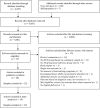Research Review: Internalising symptoms in developmental coordination disorder: a systematic review and meta-analysis
- PMID: 30485419
- PMCID: PMC7379561
- DOI: 10.1111/jcpp.13001
Research Review: Internalising symptoms in developmental coordination disorder: a systematic review and meta-analysis
Abstract
Background: Developmental coordination disorder (DCD) affects 5%-6% of children. There is growing evidence that DCD is associated with greater levels of internalising symptoms (i.e. depression and anxiety). This is the first systematic review and meta-analysis to explore the magnitude of this effect, the quality of the evidence and potential moderators.
Methods: A systematic search was conducted to identify studies reporting a comparison between individuals with DCD/probable DCD and typically developing (TD) individuals on measures of internalising symptoms. A pooled effect size (Hedges g) was calculated using random-effects meta-analysis. Study quality, publication bias and potential moderators of the effect were explored.
Results: Twenty studies, including a total of 23 subsamples, met the inclusion criteria, of which 22 subsamples were included in the meta-analysis (DCD: n = 1123; TD: n = 7346). A significant, moderate effect of DCD on internalising symptoms was found (g = 0.61). This effect remained robust after accounting for publication bias and excluding lower quality studies. The effect was significantly larger in studies utilising a cross-sectional design (vs. longitudinal), convenience sampling (vs. population screening) and a majority male sample.
Conclusions: The findings demonstrate that individuals with DCD experience greater levels of internalising symptoms than their peers. This highlights the importance of routine screening for emotional difficulties in DCD, raising awareness of the condition in mental health services and developing psychosocial interventions that extend beyond a focus on motor impairments. However, there is a need for higher quality, longitudinal studies to better understand the causal relationship between DCD and internalising symptoms.
Keywords: Developmental coordination disorder; anxiety; depression; internalising symptoms; mental health; meta-analysis.
© 2018 The Authors. Journal of Child Psychology and Psychiatry published by John Wiley & Sons Ltd on behalf of Association for Child and Adolescent Mental Health.
Figures
Similar articles
-
Internalising symptoms in Developmental Coordination Disorder: The indirect effect of everyday executive function.Res Dev Disabil. 2021 Feb;109:103831. doi: 10.1016/j.ridd.2020.103831. Epub 2020 Dec 25. Res Dev Disabil. 2021. PMID: 33360963
-
Differences in walking and running gait in children with and without developmental coordination disorder: A systematic review and meta-analysis.Gait Posture. 2021 Jan;83:177-184. doi: 10.1016/j.gaitpost.2020.10.013. Epub 2020 Oct 29. Gait Posture. 2021. PMID: 33160227
-
Balance control in individuals with developmental coordination disorder: A systematic review and meta-analysis.Gait Posture. 2021 Jan;83:268-279. doi: 10.1016/j.gaitpost.2020.10.009. Epub 2020 Oct 17. Gait Posture. 2021. PMID: 33227605
-
Children with Autism Spectrum Disorder, Developmental Coordination Disorder, and typical development differ in characteristics of dynamic postural control: A preliminary study.Gait Posture. 2019 Jan;67:9-11. doi: 10.1016/j.gaitpost.2018.08.038. Epub 2018 Sep 14. Gait Posture. 2019. PMID: 30245240 Free PMC article.
-
Emotional and behavioural problems in children with Developmental Coordination Disorder: Exploring parent and teacher reports.Res Dev Disabil. 2017 Nov;70:67-74. doi: 10.1016/j.ridd.2017.08.001. Epub 2017 Sep 12. Res Dev Disabil. 2017. PMID: 28915470
Cited by
-
Motor Performance in Association with Perceived Loneliness and Social Competence in 11-Year-Old Children Born Very Preterm.Children (Basel). 2022 May 4;9(5):660. doi: 10.3390/children9050660. Children (Basel). 2022. PMID: 35626837 Free PMC article.
-
A Qualitative Investigation into the Experiences of Students with Developmental Coordination Disorder (DCD/Dyspraxia) in Higher Education.Eur J Investig Health Psychol Educ. 2024 Dec 20;14(12):3099-3122. doi: 10.3390/ejihpe14120203. Eur J Investig Health Psychol Educ. 2024. PMID: 39727511 Free PMC article.
-
How are you getting by? Coping in developmental coordination disorder versus attention-deficit/hyperactivity disorder.Br J Occup Ther. 2023 Jan;86(1):42-52. doi: 10.1177/03080226221113505. Epub 2022 Jul 19. Br J Occup Ther. 2023. PMID: 40337183 Free PMC article.
-
Prosopagnosia is highly comorbid in individuals with probable developmental coordination disorder.Q J Exp Psychol (Hove). 2025 Aug;78(8):1501-1522. doi: 10.1177/17470218241275977. Epub 2024 Aug 13. Q J Exp Psychol (Hove). 2025. PMID: 39138399 Free PMC article.
-
Children With Developmental Coordination Disorder Exhibit Greater Stepping Error Despite Similar Gaze Patterns and State Anxiety Levels to Their Typically Developing Peers.Front Hum Neurosci. 2020 Jul 28;14:303. doi: 10.3389/fnhum.2020.00303. eCollection 2020. Front Hum Neurosci. 2020. PMID: 32848677 Free PMC article.
References
-
- American Psychiatric Association (2013). Diagnostic and statistical manual of mental disorders (5th edn). Washington, DC: American Psychiatric Association.
-
- Blank, R. , Smits‐Engelsman, B. , Polatajko, H. , & Wilson, P. (2012). European Academy for Childhood Disability (EACD): Recommendations on the definition, diagnosis and intervention of developmental coordination disorder (long version). Developmental Medicine & Child Neurology, 54, 54–93. - PubMed
-
- Borenstein, M. , Hedges, L.V. , Higgins, J.P.T. , & Rothstein, H.R. (2009). Introduction to meta‐analysis. West Sussex, UK: Wiley.
-
- Cairney, J. , Rigoli, D. , & Piek, J. (2013). Developmental coordination disorder and internalizing problems in children: The environmental stress hypothesis elaborated. Developmental Review, 33, 224–238.
Publication types
MeSH terms
LinkOut - more resources
Full Text Sources
Medical
Miscellaneous



